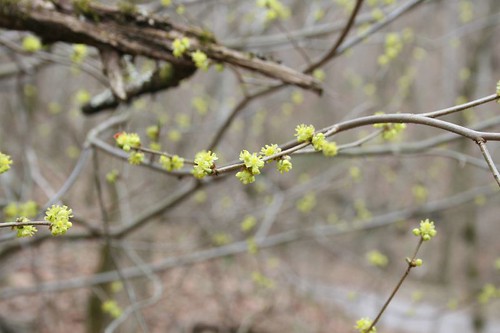Along one side of our yard, our neighbor has a forsythia hedge whose cheery yellow flowers are a magnificent joy in spring. But you won't find forsythia in the woods (at least, not yet): it's from China. Instead, we look every year for the less showy but equally cheery flowers of the spicebush as they emerge to light up the understory of our local forests. On our hike yesterday, they looked like they were ready to burst open any day now.
For us, spicebush is a way to mark the passing of the seasons. We wrote about spicebush last September, when the bright red berries were marking the beginning of fall. Now is the time to look for the flowers that create those berries: they're a harbinger of spring (and much more reliable than groundhogs).
The flowers of spicebush appear in clusters along the stems, before the leaves emerge. Each flower has five small petals. (For comparison, forsythia has only four petals per flower. So does witch hazel, whose wispy yellow flowers otherwise can seem quite similar -- except that they bloom over the winter.)
Between the early spring flowers and the vibrant red berries, we're mystified as to why spicebush isn't a more common plant in yards and other ornamental plantings. It also has high wildlife value -- it serves as a host plant for beautiful spicebush swallowtails and promethea moths, while the berries feed birds and other critters.
The spicy twigs and berries of spicebush (think allspice) also have been used by humans for teas and flavorings for centuries (maybe millenia). They aren't attractive to deer, though -- which likely explains why spicebush remains common in our local woods even as the out-of-balance deer population is stripping out most of the rest of the understory.
If the deer are going to leave us just one shrub, we'll take spicebush, and with pleasure. It's a great way to greet the spring.
In the wild: Spicebush is one of our dominant understory shrubs. One of the most impressive areas we know is in Rock Creek Park, in the section east of Boundary Bridge. But you'll probably see some spicebush in just about any woods in the DC metro area.
In your yard: Spicebush needs shade, but a few hours of sun will encourage them to flower more and set more fruit. They can also suffer if they get too dry, especially as they're getting established -- they'll do best with reasonably moist soil.
skip to main |
skip to sidebar
Recent Posts
Popular
Car-Free DC: Ten Great Places to Hike Around DC by Public Transportation (and Counting)
Car-Free DC: Rock Creek Park
LOOK FOR: Monarch Caterpillars (and Raise Them!)
Getting Kids Into Nature: Great Websites
Car-Free DC: Glover Archbold Park
LOOK FOR: Sumac Berries
Scott's Run Nature Preserve
Attachment to Nature Parenting: 10 Tools to Give Kids a Passion for Nature
Patuxent River Park: Jug Bay Natural Area
Car-Free DC: Rock Creek Park
LOOK FOR: Monarch Caterpillars (and Raise Them!)
Getting Kids Into Nature: Great Websites
Car-Free DC: Glover Archbold Park
LOOK FOR: Sumac Berries
Scott's Run Nature Preserve
Attachment to Nature Parenting: 10 Tools to Give Kids a Passion for Nature
Patuxent River Park: Jug Bay Natural Area
Comments
Links & Tweets
Twitter Updates
Calendar
We don't check for updates - you may want to check in with the trip leaders or sponsoring organizations!
Key: volunteering - kids & families - everything else
Archive
-
▼
2010
(34)
-
▼
March
(13)
- LOOK FOR: Bloodroot, a Delicate White Flower with ...
- C&O: the McKee-Beshers Wildlife Management Area
- Calendar: Learn About Native Plants, and Buy Some
- LOOK FOR: Spicebush Flowers, North America's Answe...
- Learn Your Wildflowers and Wild Edibles: Sign Up f...
- Calendar: The Potomac Heritage Trail
- LOOK FOR: Fairy Spuds, More Commonly Known as Spri...
- In pictures: Waiting for Spring
- Environmental Film Festival: March 16-28
- Calendar: Visit Two Threatened Creeks
- LOOK FOR: Yellow-Bellied Sapsuckers
- In Pictures: Thaw
- New & Improved Natural Capital: Thanks for Your Fe...
-
▼
March
(13)





